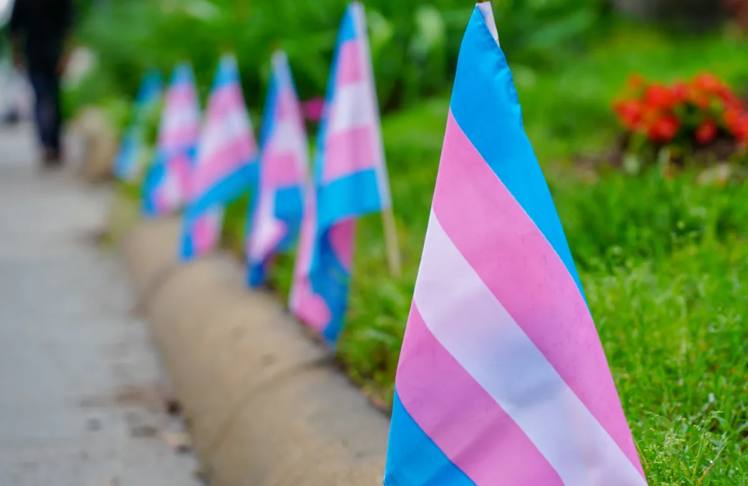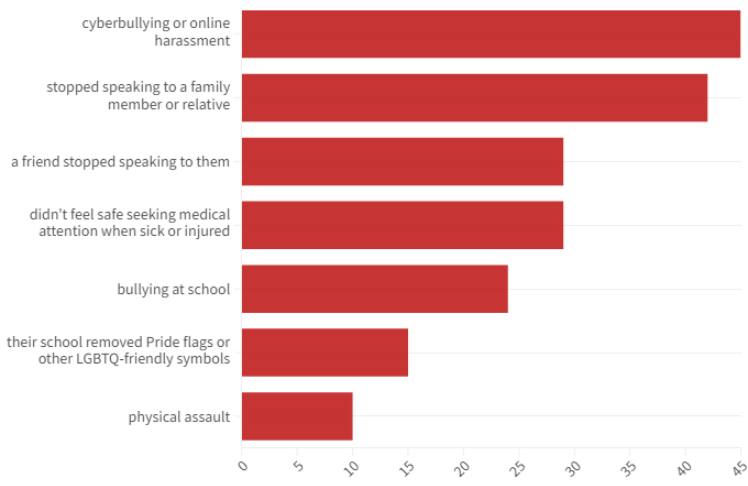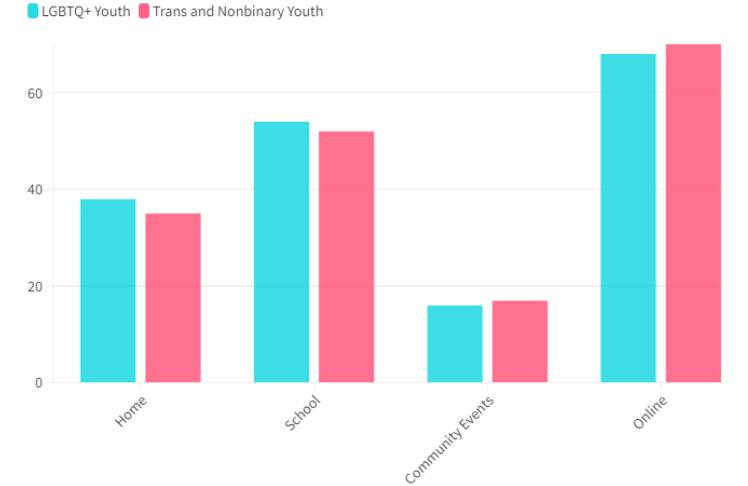

This article is one of a series of articles produced by Word in Black through support provided by the Chan Zuckerberg Initiative. Word In Black is a collaborative of 10 Black-owned media outlets across the country.
Barely six months into 2023, there have already been 80 anti-trans bills passed around the country. This is a more than 200% increase than all of 2022.
Aside from the national bills, they’ve only been passed in 21 states — and about half of those are Southern states.
This is where “a disproportionate amount of Black, queer, and trans youth live,” says Victoria Kirby York, the deputy executive director of the National Black Justice Coalition. And many of these bills target gender-affirming care, which Kirby York calls a “hope being dashed or dream being deferred.”
“For many of these young people, being able to have access to hormone replacement therapy before puberty is critical to being able to start school, their college application journey,” Kirby York says, “and their life, generally, once they finish high school fully as the person that that they want to be seen as in the world.”
And, she says, like with anything else, “When white America has a cold, the Black community has pneumonia.”
“As a community, we have to wrap our arms around our trans and gender non-conforming youth even more,” Kirby York says, “because they’re being attacked from all sides.”
The Mental Health Impact
In the years it’s been monitoring LGBTQ+ youth mental health, The Trevor Project found that anxiety, depression, suicidal ideation, and suicide attempts have been relatively stable — which is both good and bad.
“It does suggest that we’re not seeing improvements, and we still have work to do,” says Dr. Myeshia Price, director of research science at The Trevor Project. “But I do want to point out that the rates are higher when we start looking at the intersection of queer identities.”
Nearly one in four Black transgender and nonbinary youth attempted suicide in the last year, according to a February 2023 report by The Trevor Project. This is more than twice the rate of cisgender Black LGBTQ+ youth. And other mental health impacts are very prevalent: 75% report having anxiety symptoms, 67% report depression symptoms, and 58% report seriously considering suicide.
The combination of mental health remaining steady and the high numbers of folks experiencing these symptoms may seem contradictory, but there’s a lot of nuance, Price says.
It’s not just one factor that determines someone’s mental health. So while youth are absolutely paying attention to what’s happening across the country, and some are living where these policies are being enacted, there are also some in places where “their day-to-day isn’t that bad,” Price says.
“They may be in a safe community. They may be surrounded by people who appreciate them and are affirming of them,” Price says. “And we have to remember that there are states that are actively working to protect LGBTQ young people.”
But, across all races and ethnicities, 86% of transgender and nonbinary youth said the recent onslaught of anti-trans bills has negatively impacted their mental health, according to a separate Trevor Project poll. For example, nearly half of trans youth were cyberbullied, and about 33% didn’t feel safe going to see a medical professional.
Following anti-trans policies and debates in the last year, trans and nonbinary youth have reported an increase in harmful experiences.

When barriers are put in the way of you accomplishing a dream, it has a “drastic impact” on your mental health, Kirby York says. For some trans kids, it can mean no longer being able to be part of an athletic team or being cut out of hobbies they’ve had since they were kids. For others, it can mean worrying about getting accepted to or fitting in at college because they couldn’t start gender-affirming care at the recommended age.
This is really harmful to a young person’s psyche.
“If you don’t have something to live for, our youth think, ‘What’s the point of living?’” Kirby York says. “If the thing I’ve been pushing toward since I was a little kid, I can’t accomplish because there’s this barrier that’s been put in front of me, what’s the point?”
Finding Support And Affirmation
Having access to supportive and affirming spaces is crucial for trans and nonbinary youth, especially in the two places they spend the most time: home and school.
Affirming spaces and people are protective, Price says. Ultimately, having those saves young lives. No matter the intersection, Price says, having affirming homes and schools leads to lower rates of suicide, but the protective family support is especially vital for Black trans and nonbinary youth.
School and online communities were identified as the top affirming spaces for LGBTQ+ youth, according to The Trevor Project’s 2023 national survey. Less than half of LGBTQ+ youth identified home as one of these spaces.
School and online communities were the most affirming spaces for LGBTQ+ youth.

Schools can be affirming by respecting students’ pronouns, allowing students to access the bathroom that matches their gender identity, and showing visibility, whether it’s through lesson plans or posters around the building.
But in states and districts around the country where those practices are not in place, and homes are not affirming, we see dangerous spikes in youth mental health and a lack of support, Kirby York says.
“We’ve seen, with the various suicide hotlines across the country that focus on trans youth and LGBTQ youth more broadly, an increase in calls from some of those areas,” Kirby York says. “The stranger on the other side of the phone is the only place they’re able to get affirmation and support and someone who can save their life.”
Working Toward Acceptance
Living at the intersection of being Black and queer means racism and discrimination can come from both of your communities.
“Oftentimes, they’re put in this really tough position where they’re not able to bring their full, whole selves to the table,” Price says. “There’s a different rate of acceptance for young people with these different identities.”
So it can be exceptionally harmful that Black adults are struggling to recognize trans and nonbinary people. In fact, 68% of Black adults say that gender is determined by the sex a person was assigned at birth, according to a Pew Research Center poll.
When it comes to how accepting society should be of trans people, Black adults are split. While 29% say society has gone too far in accepting trans people, 36% say not far enough, and 31% say it’s been about right.
But Kirby York sees something else in these numbers.
“The percent that says we’ve gone too far is actually in the minority when you look at how they contrast to those other two data points,” Kirby York says. “Those two data points that say we’re about right or need to go further represent the growing majority of people who, when they say ‘liberty and justice for all’ in the Pledge of Allegiance, really mean that.”
But, she says, the 29% who think society has gone too far highlights that there still needs to be a lot more education and “real talk with members of our community about who trans people are and have always been in our community.”
Education Is Critical
Moving toward more widespread acceptance and support requires education and understanding.
Price wants people to understand that young people are not prone to suicide risk because of their sexual orientation or gender identity “in and of itself.” This misconception leads people into thinking the best way to protect their child is to stop them from being this way.
“We know that this risk in mental health outcomes is due to the way that they’re treated, due to the stigma, due to societal treatment,” Price says. “And we know this in the Black community. We know that if we were treated better, things would be better for us. That can be extended to our understanding of trans or nonbinary people.”
Educating the nearly quarter of Black adults that think society has gone too far in accepting trans people is “really critical in order to help them be able to better affirm the people in their lives,” Kirby York says.
This would lead to fewer youth suicides, fewer adults struggling with mental health, Kirby York says, and a Black community “that is fully able to thrive and knock down these barriers.”
“We shouldn’t be creating barriers for our own people in addition to the ones that we already faced,” Kirby York says. “Some folks just need an opportunity to understand who the trans community is more deeply, and to have access to tools that will allow them to be able to better understand and affirm members of their community with a trans identity.”















